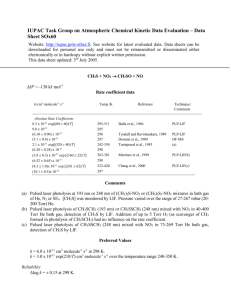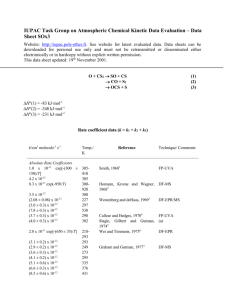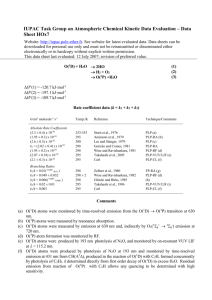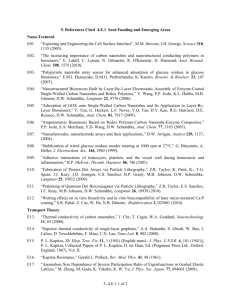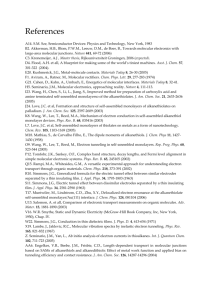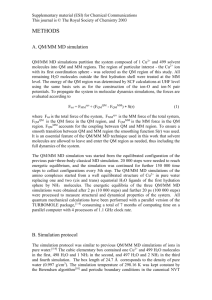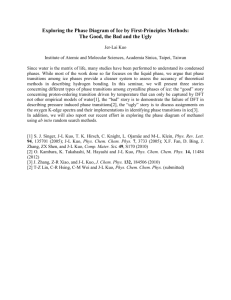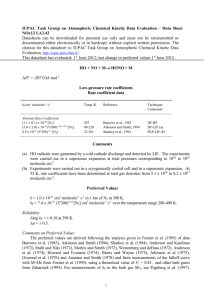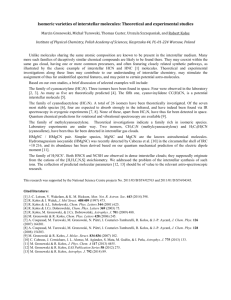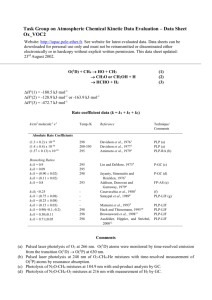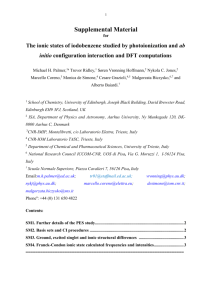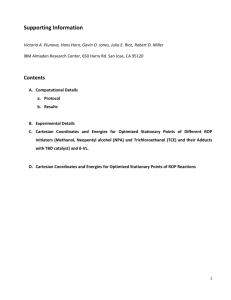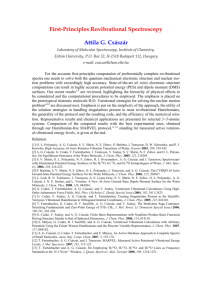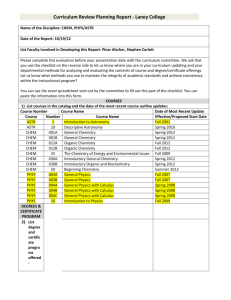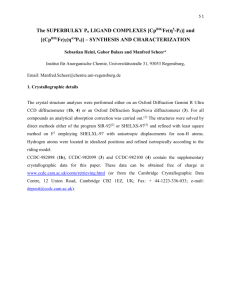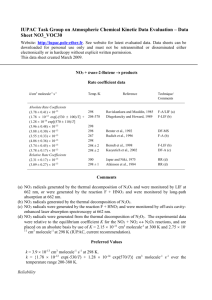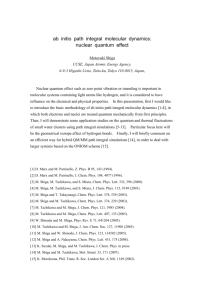IUPAC Task group on Atmospheric chemical Kinetic Data Evaluation
advertisement
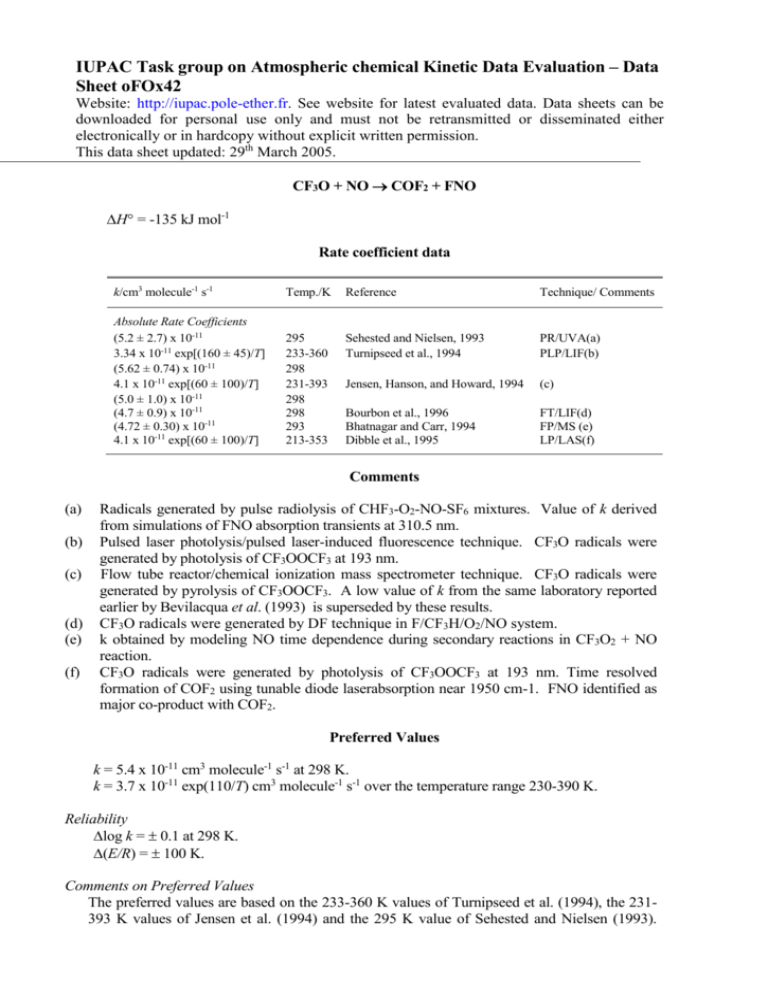
IUPAC Task group on Atmospheric chemical Kinetic Data Evaluation – Data Sheet oFOx42 Website: http://iupac.pole-ether.fr. See website for latest evaluated data. Data sheets can be downloaded for personal use only and must not be retransmitted or disseminated either electronically or in hardcopy without explicit written permission. This data sheet updated: 29th March 2005. CF3O + NO COF2 + FNO H = -135 kJ mol-1 Rate coefficient data k/cm3 molecule-1 s-1 Temp./K Reference Technique/ Comments Absolute Rate Coefficients (5.2 ± 2.7) x 10-11 3.34 x 10-11 exp[(160 ± 45)/T] (5.62 ± 0.74) x 10-11 4.1 x 10-11 exp[(60 ± 100)/T] (5.0 ± 1.0) x 10-11 (4.7 ± 0.9) x 10-11 (4.72 ± 0.30) x 10-11 4.1 x 10-11 exp[(60 ± 100)/T] 295 233-360 298 231-393 298 298 293 213-353 Sehested and Nielsen, 1993 Turnipseed et al., 1994 PR/UVA(a) PLP/LIF(b) Jensen, Hanson, and Howard, 1994 (c) Bourbon et al., 1996 Bhatnagar and Carr, 1994 Dibble et al., 1995 FT/LIF(d) FP/MS (e) LP/LAS(f) Comments (a) (b) (c) (d) (e) (f) Radicals generated by pulse radiolysis of CHF3-O2-NO-SF6 mixtures. Value of k derived from simulations of FNO absorption transients at 310.5 nm. Pulsed laser photolysis/pulsed laser-induced fluorescence technique. CF3O radicals were generated by photolysis of CF3OOCF3 at 193 nm. Flow tube reactor/chemical ionization mass spectrometer technique. CF3O radicals were generated by pyrolysis of CF3OOCF3. A low value of k from the same laboratory reported earlier by Bevilacqua et al. (1993) is superseded by these results. CF3O radicals were generated by DF technique in F/CF3H/O2/NO system. k obtained by modeling NO time dependence during secondary reactions in CF3O2 + NO reaction. CF3O radicals were generated by photolysis of CF3OOCF3 at 193 nm. Time resolved formation of COF2 using tunable diode laserabsorption near 1950 cm-1. FNO identified as major co-product with COF2. Preferred Values k = 5.4 x 10-11 cm3 molecule-1 s-1 at 298 K. k = 3.7 x 10-11 exp(110/T) cm3 molecule-1 s-1 over the temperature range 230-390 K. Reliability log k = 0.1 at 298 K. (E/R) = 100 K. Comments on Preferred Values The preferred values are based on the 233-360 K values of Turnipseed et al. (1994), the 231393 K values of Jensen et al. (1994) and the 295 K value of Sehested and Nielsen (1993). These results are in good agreement. The low value of k reported by Bevilacqua et al. (1993) has been superseded by the results of Jensen et al. (1994). Room temperature results from Bourbon et al. (1996) and Bhatnagar and Carr (1994) and a temperature dependence study of Dibble et al (1995) are in good agreement with the recommendation. The reaction products have been reported by Chen et al. (1992), Bevilacqua et al. (1993) and Li and Francisco (1991). References Bevilacqua, T. J., Hanson, D. R. and Howard, C. J.: J. Phys. Chem., 97, 3750, 1993. Bhatagar, A. and Carr, R.W.: Chem.Phys.Lett., 231, 454, 1994. Bourbon, C., Briuokov, M., Hanoune, B., Sawersyn, J. P. and Devolder, P.: Chem.Phys.Lett., 254, 203, 1996. Chen, J., Zhu, T.and Niki, H.: J. Phys. Chem. 96, 6115, 1992. Dibble, T. S., Maricq, M. M., Szente, J. J. and Francisco, J. S.: J. Phys. Chem., 99, 17394, 1995. Jensen, N. R., Hanson, D. R. and Howard, C. J.: J. Phys. Chem., 98, 8574, 1994. Li, Z. and Francisco, J. S.: Chem. Phys. Lett., 186, 336 , 1991. Sehested, J. and Nielsen, O. J.: Chem. Phys. Lett., 206, 369, 1993. Turnipseed, A. A., Barone, S. B. and Ravishankara, A. R.: J. Phys. Chem., 98, 4594, 1994.


